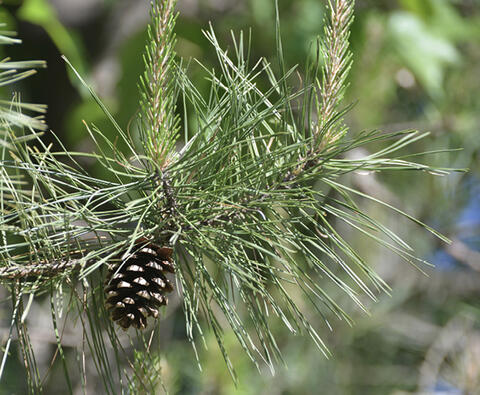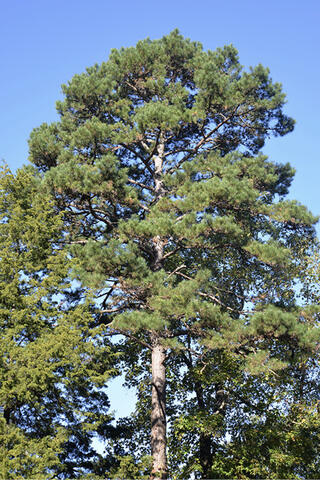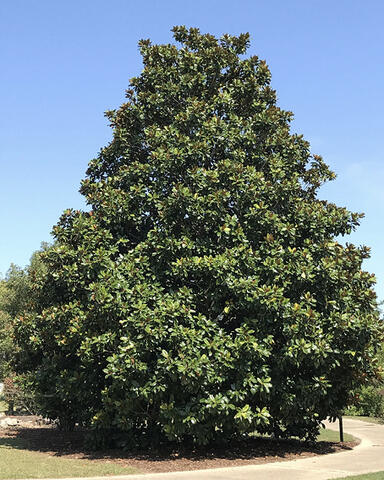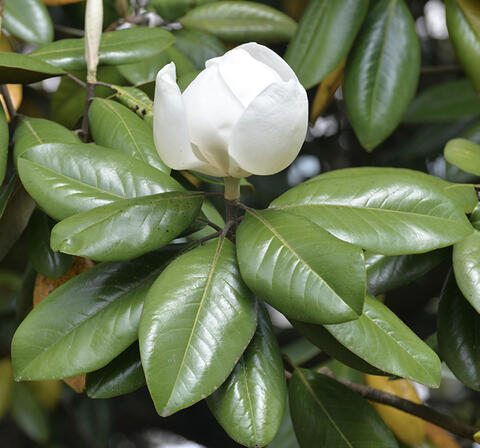P3569
Drought-Tolerant Trees for Mississippi Landscapes
Mississippi has a humid, subtropical climate. Summers are long and hot, but winters are relatively mild. Northern Mississippi experiences three to four summer months with temperatures above 86ºF, whereas south Mississippi experiences four to five months of such temperatures. Much of the year, prevailing southerly winds bring humid air from the Gulf of Mexico across the state.
Precipitation is abundant and distributed through the year. Northern Mississippi receives about 55 inches of precipitation annually, while southern Mississippi receives about 65 inches. Southern Mississippi experiences more thunderstorms during the summer, as well as tropical storms and hurricanes.
Despite the abundant annual precipitation, seasonal droughts typically occur each year. It is usually driest between September and November. Therefore, when planting trees, it is important to consider drought tolerance. This is particularly true for drier upland sites, non-irrigated yards, and along streets. Often, trees in cities have very limited rooting space, so being able to tolerate drought is important.
Water Conservation
Trees that are adapted to the landscape will need minimal irrigation. Native trees have evolved with the soil, drainage, climatic, and weather conditions found across Mississippi. These should be the first choice when selecting material to plant.
Mississippi soils tend to be low in organic matter, which decomposes quickly in the warm and humid climate. Adding organic matter is a great way to enhance soil fertility and structure and retain moisture and plant nutrients, especially in sandy or clay soils. It is best to add organic matter when planting a new bed, so you can treat the entire area. Add several inches of organic material to the top of the soil, and then disk or till to a depth of 6–10 inches.
Adding mulch around trees also helps conserve moisture. Organic mulches such as pine straw or cypress bark can improve soil organic matter content in established beds. Mulch can also reduce competition from unwanted weeds and stabilize soil temperature in the rooting zone by keeping roots warmer in winter and cooler in summer. Ideally, the mulched area should extend to the canopy dripline, spread about 2–4 inches deep, but not cover the flare at the root collar where roots meet the stem. In addition, mulched beds will keep mowers and string trimmers away from trees, preventing damage to the trunk and roots.
Finally, if supplemental watering is necessary, drip irrigation is best for conserving water. Tree roots respond best to watering over a long period of time, which wets the soil deeply. This encourages tree roots to grow deeper. When using a soaker hose, spread it under the tree canopy, letting the water run for several hours once per week during drought. This will help improve tree survival. This is especially useful for mature, established trees that do not tolerate environmental stresses as well as vigorously growing younger trees. Move the hose to water other trees in the yard as needed.
Tree Selection and Establishment
Besides matching trees to the appropriate site conditions, it is very important to consider the growing space available. When selecting trees for planting, consider the mature size. Trees that grow large, such as oaks or pines, may not be the best selection for planting in cityscapes where rooting space is limited and overhead utilities abound. Call 8-1-1 to locate buried utilities before digging. This is a free service that also functions as a safety precaution against damaging buried electric or gas lines. If you use this service and still hit a buried utility, this program limits your liability for damages.
Given Mississippi’s warm climate, soils do not freeze through the winter. The best time to plant container or balled/burlapped trees is in the fall. Since soils are above freezing, tree roots remain active through the winter. This enhances the ability of a recently planted tree to adapt to its new environment, which can take 8–10 weeks. In addition, the cooler temperatures during fall are less stressful to transplanted trees than warming temperatures in the spring. Many trees planted in autumn will become established before the summer heat, which reduces the need for supplemental watering. On the other hand, trees planted in the spring often require additional care through the first growing season. However, transplant bareroot trees, or move established trees in the landscape, only during dormancy in the winter (late December to early March).
Dig the planting hole two to three times the diameter of the root ball. This allows tree roots to grow freely into the soil. Also, the hole should be only as deep as the current root ball. When removing the container, look for circling roots. Roots grow in the direction they are pointing, so prune circling roots so that they point outward from the stem before planting. Use the soil you removed to backfill the planting hole. Apply water generously while backfilling so the roots will make good contact with soil. Use any extra soil to form a small berm along the perimeter of the planting hole. This berm will hold water over the new planting site. Cover with 2–4 inches of mulch.
Drought-Tolerant Trees
Drought tolerance involves several characteristics that allow the tree to conserve moisture. It does not mean the trees prefer dry sites, just that they can tolerate them. One of the most important characteristics is the well-developed root system of an established tree. It can take 2 months to a year for a newly planted tree to acclimate. This is an important consideration when planting trees, especially in environmentally challenging areas such as dry sites.
Like many plants, trees can reduce transpiration through their leaves to save moisture. Those that are adapted to dry sites do this more effectively than other species. Smaller leaves allow trees to cool more easily. Deeper crowns with multiple layers of leaves allow trees to reduce transpiration to outer leaves exposed to direct sun, but still transpire through shaded leaves within the canopy. Waxy coatings on leaves (common with evergreen trees) reduce moisture loss. Early successional species adapted to growing in full sun are more efficient at conserving moisture than late successional species that are used to growing in the shade of other trees.
There are many examples of drought-hardy trees. One of the more notable species is shortleaf pine (Pinus echinata; Figure 1). Shortleaf pine is also unique among pine species for being able to sprout from its roots as a juvenile tree; this is an adaptation to frequent ground fires. It also has the most extensive range of the southern yellow pines. It is found in 23 states from southern New York to northern Florida, and west to eastern Texas and Oklahoma. It grows inland across western Pennsylvania, southern Ohio, Illinois, and Missouri. It is adapted to drier, upland sites.


Another example of a drought-tolerant tree is southern magnolia (Magnolia grandiflora; Figure 2). This evergreen hardwood species is the Mississippi state tree and flower. Its leaves have a thick, waxy cuticle that allows them to survive winter temperatures. While native to southern Mississippi, southern magnolia has been widely planted across the state and the country.


These are just two examples of drought-tolerant trees. Table 1 lists others, with the major common name for a tree followed by its scientific name in italics. The table presents drought tolerance for established trees with well-developed root systems, not recently planted trees. Tree species are listed with their approximate total height and canopy spread when mature. There are some additional comments about environmental preferences for each species. Photos for many of the trees listed can be found in Mississippi Trees.
Not all of the listed trees will grow everywhere in Mississippi. The state spans several plant hardiness zones north to south. Some species, like wax myrtle (Morella cerifera), will grow only in southern Mississippi, whereas other species, like bur oak (Quercus macrocarpa), are better suited to northern Mississippi.
Several drought-tolerant tree species are not necessarily suitable to plant for other reasons. These include red maple (Acer rubrum) and green ash (Fraxinus pennsylvanica). Red maple has brittle wood, so it should not be planted near structures, driveways, or roads. Green ash is susceptible to an invasive insect, the emerald ash borer (Agrilus planipennis). Once this borer attacks an ash, the tree will be killed within a few years. At this time, the emerald ash borer has not been documented in Mississippi, but it is found in every adjacent state. Finally, make sure your selected tree is not an invasive plant. If you are not sure, contact your local Extension office.
|
Tree |
Species |
Mature height (ft) |
Canopy width (ft) |
Comments |
|---|---|---|---|---|
|
American holly |
Ilex opaca |
50 |
40 |
Prefers full sun to partial shade |
|
American smoketree* |
Cotinus obovatus |
30 |
30 |
Requires full sun; multi-stemmed; beautiful fall color |
|
American witchhazel |
Hamamelis virginiana |
30 |
20 |
Prefers growing on northern exposures or in shade |
|
Arizona cypress* |
Hesperocyparis arizonica |
50 |
30 |
Native to the southwestern U.S.; adapted to dry soils |
|
Bald cypress |
Taxodium distichum |
75 |
25 |
Requires full sun; slow-growing; deciduous conifer |
|
Black oak |
Quercus velutina |
60 |
60 |
Prefers acidic, well-drained soils in full sun |
|
Black walnut |
Juglans nigra |
75 |
75 |
Requires full sun and rich, well-drained soils |
|
Blackgum |
Nyssa sylvatica |
50 |
30 |
Tolerates full sun to partial shade; prefers moist soil |
|
Blackjack oak |
Quercus marilandica |
35 |
25 |
Scrub oak commonly found on poor sites |
|
Bur oak* |
Quercus macrocarpa |
80 |
80 |
Native to the Midwest; suitable for north-central MS |
|
Cabbage palm |
Sabal palmetto |
65 |
15 |
Coastal tree suitable for growing in southern MS |
|
Carolina buckthorn |
Frangula caroliniana |
40 |
40 |
Prefers partial shade; excellent wildlife tree |
|
Carolina laurelcherry |
Prunus caroliniana |
40 |
25 |
Small tree suitable for growing in southern MS |
|
Cedar elm |
Ulmus crassifolia |
70 |
60 |
Requires full sun |
|
Chalk maple |
Acer leucoderme |
25 |
25 |
Prefers shade; commonly multi-stemmed |
|
Chickasaw plum |
Prunus angustifolia |
25 |
15 |
Prefers full sun but tolerates partial shade |
|
Chinese elm* |
Ulmus parvifolia |
50 |
45 |
Prefers full sun but tolerates partial shade |
|
Chinese magnolia* |
Magnolia × soulangiana |
30 |
25 |
Requires full sun; prefers fertile, well-drained soil |
|
Chinese pistache* |
Pistacia chinensis |
35 |
35 |
Requires full sun; fast-growing |
|
Chinquapin |
Castanea pumila |
30 |
20 |
Prefers full sun to partial shade; nuts attract a variety of wildlife |
|
Chinquapin oak |
Quercus muehlenbergii |
50 |
60 |
Requires full sun; moderate growth rate |
|
Common persimmon |
Diospyros virginiana |
60 |
35 |
Prefers full sun and moist, well-drained soils |
|
Crape myrtle* |
Lagerstroemia indica |
variable |
variable |
Multi-stemmed; cultivars in various sizes and flowers of all colors |
|
Deodar cedar* |
Cedrus deodara |
70 |
40 |
Requires full sun; moderate growth rate |
|
Darlington oak |
Quercus hemisphaerica |
60 |
40 |
Requires full sun and drier upland sites; fast-growing |
|
Desert willow* |
Chilopsis linearis |
30 |
20 |
Requires full sun; multi-stemmed; native to the southwestern U.S. |
|
Eastern redbud |
Cercis canadensis |
30 |
35 |
Beautiful lavender flowers in early spring |
|
Eastern redcedar |
Juniperus virginiana |
50 |
20 |
Prefers full sun but tolerates partial shade; slow-growing |
|
Green ash |
Fraxinus pennsylvanica |
60 |
25 |
Requires full sun; fast-growing; susceptible to emerald ash borer |
|
Honeylocust |
Gleditsia triacanthos |
70 |
50 |
Requires full sun; does have thorns |
|
Japanese zelkova* |
Zelkova serrata |
80 |
75 |
Prefers full sun and deep, well-drained soils |
|
Laurel oak |
Quercus laurifolia |
70 |
45 |
Requires full sun; fast-growing; evergreen |
|
Lilac chastetree* |
Vitex agnus-castus |
20 |
20 |
Requires full sun |
|
Live oak |
Quercus virginiana |
80 |
120 |
Prefers full sun; canopy grows wider than tall; evergreen |
|
Loblolly pine |
Pinus taeda |
100 |
35 |
Prefers full sun; avoid planting near structures (wood is brittle) |
|
Longleaf pine |
Pinus palustris |
120 |
40 |
Requires full sun; adaptable to many soil conditions |
|
Maidenhair tree* |
Ginkgo biloba |
80 |
40 |
Tolerates urban plantings; use male trees ornamentally |
|
Nuttall oak |
Quercus texana |
60 |
50 |
Requires full sun; fast-growing |
|
Osage-orange* |
Maclura pomifera |
60 |
60 |
Naturalized from the southern plains |
|
Overcup oak |
Quercus lyrata |
70 |
50 |
Adapted to wet soil conditions |
|
Pawpaw |
Asimina triloba |
40 |
25 |
Prefers full sun to partial shade; suitable for north-central MS |
|
Pecan |
Carya illinoinensis |
100 |
75 |
Requires full sun; tolerates alkaline soil |
|
Pignut hickory |
Carya glabra |
60 |
35 |
Requires full sun; tolerates alkaline soil |
|
Pond cypress |
Taxodium ascendens |
80 |
15 |
Requires full sun; tolerates very wet soil; suitable for southern MS |
|
Possumhaw |
Ilex decidua |
30 |
20 |
Prefers full sun but tolerates partial shade |
|
Post oak |
Quercus stellata |
50 |
40 |
Slow-growing; adapted to dry, upland sites |
|
Red buckeye |
Aesculus pavia |
20 |
20 |
Prefers full sun to partial shade; blooms attract hummingbirds |
|
Red maple |
Acer rubrum |
60 |
40 |
Prefers full sun; avoid planting near structures (wood is brittle) |
|
Sand live oak |
Quercus geminata |
50 |
50 |
Prefers full sun; evergreen; suitable for coastal MS |
|
Sassafras |
Sassafras albidum |
60 |
40 |
Prefers full sun to partial shade |
|
Sawtooth oak* |
Quercus acutissima |
60 |
60 |
Requires full sun; fast-growing |
|
Saw palmetto |
Serenoa repens |
10 |
10 |
Prefers full sun to partial shade; suitable for southern MS |
|
Shortleaf pine |
Pinus echinata |
100 |
35 |
Prefers full sun to partial shade; adapted to dry, upland sites |
|
Shumard oak |
Quercus shumardii |
60 |
60 |
Requires full sun; tolerates alkaline soil |
|
Slash pine |
Pinus elliottii |
100 |
50 |
Prefers full sun to partial shade; tolerates wet soils |
|
Sourwood |
Oxydendrum arboreum |
30 |
20 |
Prefers full sun; moderate growth rate; excellent fall color |
|
Southern catalpa |
Catalpa bignonioides |
60 |
40 |
Prefers full sun to partial shade; tolerates alkaline soil |
|
Southern magnolia |
Magnolia grandiflora |
80 |
40 |
Prefers full sun to partial shade; evergreen |
|
Southern sugar maple |
Acer floridanum |
40 |
25 |
Prefers full sun to partial shade; beautiful fall color |
|
Spruce pine |
Pinus glabra |
90 |
45 |
Prefers full sun; suitable for southern MS |
|
Staghorn sumac |
Rhus typhina |
25 |
25 |
Requires full sun; tolerates alkaline soil |
|
Sugarberry |
Celtis laevigata |
60 |
60 |
Prefers sun or shade |
|
Trident maple* |
Acer buergerianum |
35 |
30 |
Prefers full sun; slow-growing |
|
Tuliptree |
Liriodendron tulipifera |
90 |
40 |
Requires full sun; fast-growing |
|
Water oak |
Quercus nigra |
80 |
80 |
Prefers full sun to partial shade |
|
Wax myrtle |
Morella cerifera |
20 |
20 |
Prefers full sun to partial shade; suitable for southern MS |
|
White oak |
Quercus alba |
80 |
80 |
Prefers full sun to partial shade |
|
Yaupon |
Ilex vomitoria |
20 |
12 |
Prefers full sun to partial shade; evergreen |
*Non-native ornamental.
The taxonomy for common and scientific names presented is in accordance with the United States Department of Agriculture, Natural Resources Conservation Service, National PLANTS Database.
References
Bachman, G. (2020). Mulches for the landscape. Mississippi State University Extension Publication 2301.
Brzuszek, R. F. (2018). Native trees for Mississippi landscapes. Mississippi State University Extension Publication 2330.
Brzuszek, R. F., Drackett, P. R., & Kelly, L. S. (2017). Water conservation in your landscape. Mississippi State University Extension Publication 3146.
Clatterbuck, W. K., & Fare, D. C. (1998). Trees to reconsider before planting. University of Tennessee, Ag Extension Service, publication SP 512.
Keck, C., Snyder, S., Gotcher, M., Schroder, J., Schnelle, M., & Moss, J. (2020). Drought-tolerant plant selections for Oklahoma. Oklahoma State University Extension, factsheet HLA-6444.
Kessler, J. R., Smith, K., and Ramey, A. (2023). Drought-tolerant landscapes for Alabama. Alabama A&M and Auburn Universities, publication ANR-1336.
Maddox, V., & Kelly, L. S. (2017). Selecting landscape trees with special comments on invasive and native plants. Mississippi State University Extension Publication 2679.
Mississippi Forestry Commission. (2016). Mississippi trees (2nd ed.).
Mississippi State University, Department of Geosciences. (n.d.) Mississippi climate.
Smith, B. H., & Russ, R. (2019). Plants that tolerate drought. Clemson University, Home and Garden Information Center, fact sheet HGIC 1717.
United States Department of Agriculture, Natural Resources Conservation Service. (2019). National PLANTS database.
United States Department of Agriculture, Natural Resources Conservation Service. (2023). USDA plant hardiness zone map.
Publication 3569 (POD-03-24)
Reviewed by Jeff Wilson, PhD, Assistant Professor, North Mississippi Research and Extension Center, from an earlier edition by John D. Kushla, PhD, Extension/Research Professor (retired), North Mississippi Research and Extension Center.
The Mississippi State University Extension Service is working to ensure all web content is accessible to all users. If you need assistance accessing any of our content, please email the webteam or call 662-325-2262.
